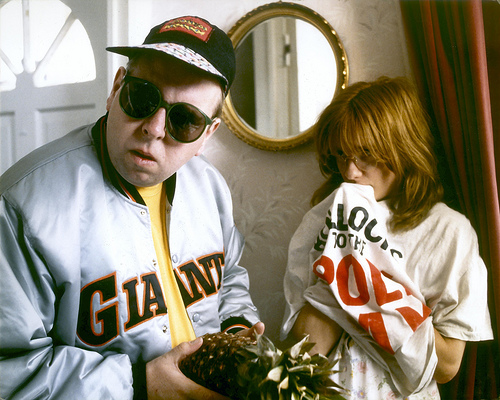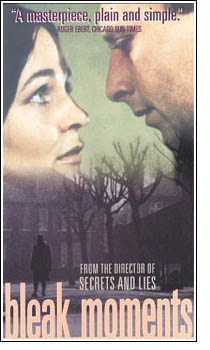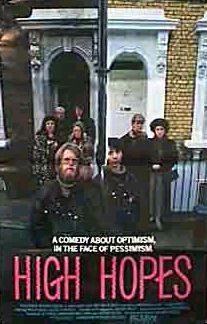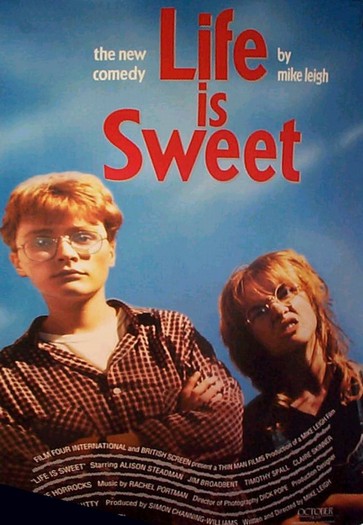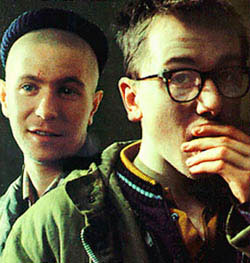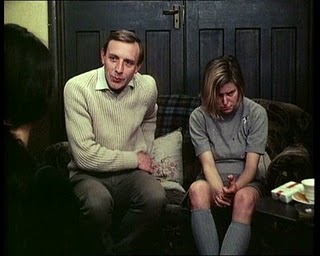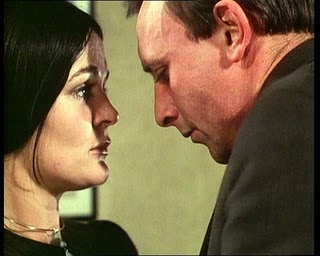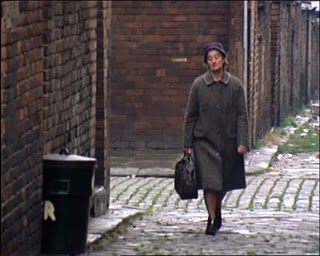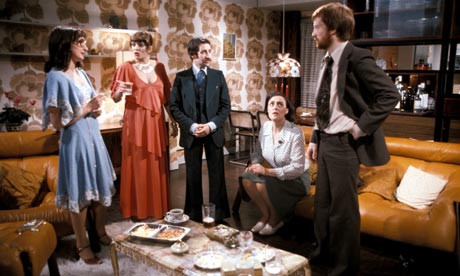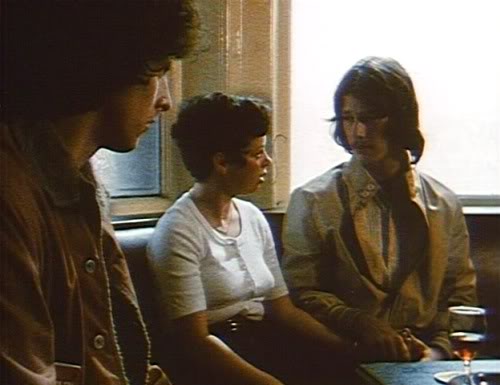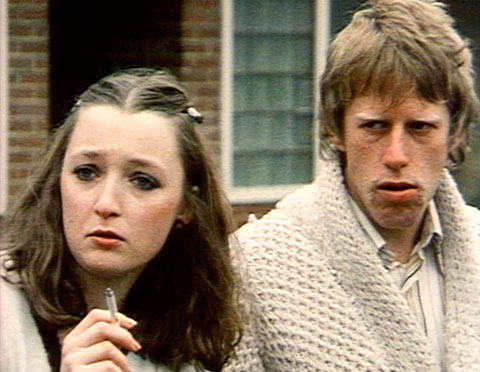From the Chicago Reader, January 10, 1992. — J.R.
THE FILMS OF MIKE LEIGH
Among the buzzwords Marshall McLuhan coined in the 60s, “global village” has always seemed one of the more dubious. The naive notion that TV brings the whole world to our doorsteps — and presumably our doorsteps to the rest of the world — seems founded on assumptions that don’t bear close scrutiny. What do we mean by “the world,” for instance? And what do we mean by TV? TV may afford us some touristic glimpses of elsewhere, along with all the usual ideological baggage of the tourist, but when it comes to closer and better understandings of foreign cultures, I suspect TV may do more harm than good by fostering complacent illusions of knowledge: images wrapped in tidy American sound bites for easy consumption, postage-stamp peeks into worlds often defined in part by what we still don’t know.
What TV seldom offers us — unless we understand other languages and possess satellite dishes — is the rare privilege of overhearing other cultures talk to themselves, experiencing them from within rather than on our terms. To be on the inside looking out offers a different kind of knowledge, attained more by osmosis and intuition than by simplification, translation, or exegesis.
Late last year I had the good fortune to visit Asia for the first time not as a tourist but as a member of a film-festival jury in Taiwan. I spent most of my time with the six other jurors — four from Taipei, one from Hong Kong, and one from New Delhi — and while our deliberations were carried out in English, many of the other conversations were in Mandarin Chinese, which everyone but the Indian juror and myself spoke. Obviously I missed a lot as a result, but I’m sure I would have missed even more if everyone had spoken only English — because most of the life of Taipei is lived in Mandarin. Similarly, I quickly discovered that the labels I had at my disposal for various forms of government — “capitalism,” “socialism,” “democracy” — were far from adequate to describe a society as different from ours as Taiwan’s, where many of the capitalist industries are state-run and where recent democratic reforms have to be weighed against a long and lingering history of martial law and censorship. (Even the issue of whether Taiwan is a country or a Chinese province is a subject of much debate there.)
When I returned from Taiwan I started looking at the TV films of English director Mike Leigh, and began to wonder why it’s taken so long for someone as gifted as Leigh to become known in the United States. His first theatrical feature, the 1971 Bleak Moments, won first prizes at both the Chicago and Locarno film festivals before receiving a limited stateside release. His second theatrical feature, High Hopes, released 17 years later, did much better; two years after that came Life Is Sweet, which is now running at the Music Box and which just won three prizes from the National Society of Film Critics (best picture, best actress, and best supporting actress). In between Bleak Moments and High Hopes, Leigh was far from inactive; in addition to writing and directing nine or ten plays in England between 1971 and 1988, he wrote and directed a dozen features and several shorts for BBC TV and England’s Channel Four. English friends of mine would periodically speak of Leigh with the sort of reverence and affection that suggested he was a kind of national treasure, but no evidence of this was available over here.
Starting this weekend, the Film Center is offering a comprehensive (if not quite exhaustive) Leigh retrospective that will run for most of the rest of this month, including Bleak Moments, High Hopes, nine TV features, and six shorts. I’ve been able to see or sample most of the lot, and it’s a remarkable body of work that offers perhaps the most in-depth portrait of English life in the 70s and 80s to be found in movies.
Last fall I saw Famous Door Theatre’s first-rate (if ill-attended) production of Leigh’s recent play Smelling a Rat — apparently the only American production his stage work has received. I’m now reading a 1979 play, Ecstasy; some sense of Leigh’s attention to local detail can be gleaned from a short note he’s appended to it: “Jean and Dawn are natives of Birmingham. Mick is from County Cork, Len is from rural Lincolnshire, and Roy and Val are from inner North London, where the play is set. The dialogue, language, and usage in Ecstasy are extremely precise, and in the author’s view the play should only be performed in the correct accents.” It might be argued that work of this kind isn’t meant for export. I can’t follow some of the printed dialogue in Ecstasy, and in some of Leigh’s movies there are times when I can’t understand what the characters are saying. (The Ulster accents in Four Days in July are especially difficult.) But still, what I see and hear in his work is closer to my own experience of England than what I’ve seen or heard in any other work; and if Leigh’s filmic oeuvre were subtitled in American English, I think the results would be more muddled than illuminating.
When I met Leigh during the last Chicago Film Festival he gave me some information about his unorthodox working methods, which have led him to prefer the credit “devised and directed by . . . ” to “written and directed by . . . ” Although he does produce a script and expects his actors to adhere to it, what comes first is a lengthy period of rehearsals, improvisation, and what he calls “research” with the actors — a working method that seems to have some relation to Stanislavsky’s.
He prepared for Life Is Sweet, for example, not only by delving into the backgrounds of the four leading characters — a mother (Alison Steadman), a father (Jim Broadbent), and their 21- year-old twin daughters (Jane Horrocks and Claire Skinner) — but also by working out in some detail what happened on all of their family trips. Since none of these trips seems to play a role in the film, one might suppose there’s something quasi-mystical about this approach. Not at all: Leigh insists that what finally counts is what appears on the stage or screen, and that the elaborate preparations are basically carried out to pinpoint the characters. In jazz terms, one might say that this process merely establishes the chord changes on which the script improvises.
This approach helps to account for the extraordinary density and reality — and frequent mystery — of many of Leigh’s characters, who always seem to have lives that extend beyond the borders of the work. But conceptual elements also figure in his construction of characters. In Life Is Sweet, Aubrey (Timothy Spall) — an oddly mannered friend of the family who opens a preposterous “gourmet” bistro called the Regret Rien — seems more a caricature than a character, but a caricature who points to something quite real in contemporary English life. Leigh told me that his principal instruction to Spall, which Spall found extremely difficult to implement, was to play someone who had no personality of his own — the implication being that Aubrey was rather like his ludicrous restaurant, a postmodernist composite of character traits borrowed willy-nilly from elsewhere.
American critics looking for non-English equivalents to Leigh’s style have often mentioned John Cassavetes, but though I’ve done it myself it’s a comparison that has limited usefulness, especially since Cassavetes doesn’t seem to have had much influence on Leigh. (In terms of working methods a closer parallel would be Jacques Rivette, in his 13-hour 1971 serial Out 1, a work with which Leigh is unacquainted.) Leigh’s films do often resemble Cassavetes’s in one important respect: they frequently seem plotless, and at any given moment it is often impossible to tell where they’re going. Though every Leigh film has a subject, often it’s not apparent until the end — or very nearly. Frequently the subject emerges when the “invisible” dramatic situation reaches a crisis — a quarrel, a burst of hysteria, even a death — and thereby becomes visible. This suggests that Leigh’s apparent artlessness is only apparent, and a closer look at his works bears this out. One discovers, for instance, that he’s a master of camera placement, but not the sort of master who calls attention to his craft.
Born in Salford, Lancashire, in 1943, Leigh has been “devising” and directing works since 1965 — at last count 21 stage plays, one radio play, 18 works for British TV, and three feature films. One of them, Bleak Moments, started out as a play, and one of his best-known TV works, Abigail’s Party (1977), is simply the videotaping of a stage production done earlier the same year. But otherwise, as far as I can tell, there’s no recycling in Leigh’s work, and judging from the dozen works that I’ve seen or sampled, their range — at least in terms of settings and characters–is impressively wide.
Class bias often seems to play an active role in Leigh’s work: the higher up the economic ladder his characters are, the more odious they usually appear. The stylistic layering in High Hopes reinforces this bias, with a concomitant increase in caricatural effect. (I haven’t seen enough of Who’s Who, which is set around the London stock exchange, to determine whether this uncharacteristic dive into the upper crust brings out more of Leigh’s venom than usual.) English writer Gilbert Adair has suggested that the moral accuracy of this bias can be more valuable than the accuracy of circumstantial details: “From Alan Bridges to Piers Haggard, and from Charles Sturridge to the man who directs the Hovis ads, the British cinema is positively crawling with filmmakers who have “got’ the ruling classes down to the last gaiter button, as they used to say, and I find it endearing and wholly to Leigh’s credit that he has pitched his tent far from that particular mainstream.”
Although some actors appear in more than one Leigh film, they’re always in different sorts of parts — most noticeably his talented wife Alison Steadman, whose only common trait in such works as Hard Labour, Abigail’s Party, The Short and Curlies, and Life Is Sweet is the highlighting of different kinds of nervous tics. Leigh doesn’t have what we would ordinarily call a repertory company. He might be said to have a workshop, which many gifted actors have passed through — including Ben Kingsley as the owner of a small taxi company in Hard Labour, Brenda Blethyn as a busybody spinster in Grown-Ups, and Tim Roth (who played van Gogh in Altman’s Vincent & Theo) and Gary Oldman as lowlifes in Meantime.
Looking at Leigh’s films chronologically, it becomes apparent that his social and political vision — which is fully apparent in his 1988 masterpiece High Hopes — took shape only gradually. Broadly speaking, his 70s work focuses on couples’ failed relationships, while his 80s work is more concerned with dysfunctional families.
Bleak Moments (1971) may have been a remarkable film debut, especially made as it was at the tail end of the “swinging London” era, but watching it is often almost agonizing — as painful in its way as listening to the out-of-tune piano played at the film’s beginning and end. (Music is often used aggressively in Leigh’s work: frequently cheerful melodies are played for an ironic or sarcastic effect.) Bleak Moments was made for 17,000 pounds — about $41,000 at the exchange rate of that period — and runs for almost two and a half hours. It chronicles the painfully awkward and embarrassed silences, usually broken only by halfhearted non sequiturs, between several south London suburbanites: a lonely accountant’s clerk living with her retarded sister; another woman working in the same office who dotes on the disabled sister; a hippie drifter and folk guitarist living in the clerk’s garage; and a stuffy, uptight schoolteacher. The clerk’s only romantic possibilities appear to be the hippie and the schoolteacher, and the interactions charted are basically missed connections. (Schoolteacher, after pedantically citing Marshall McLuhan: “Which do you find easier, watching television or radio?” Clerk: “I find it easier watching the radio.”) Besides this, nothing much happens, and any sense of a society beyond these characters is at best perfunctory.
This is not the case with Hard Labour (1973), Leigh’s first TV film, but here the society he seems to have in mind could be plotted on a chart. Basically a work of bitter and remorseless socialist realism, Hard Labour follows the exploitation and suffering of a middle-aged maid (Liz Smith) at the hands of her employers, her grown children, her husband, and finally her indifferent priest, to whom she pours out her miseries before he returns diffidently to his newspaper.
The 1977 Abigail’s Party (which might be described as Leigh’s Who’s Afraid of Virginia Woolf?) is comparably schematic, although the class and dramatic situations are quite different and this time the bitterness is played out as black comedy. A vulgar middle-class housewife (Steadman) married to a repressed man (Tim Stern) who works in real estate “entertains” her neighbors: a younger disgruntled couple consisting of a nurse (Janine Duvitsky) and her monosyllabic husband (John Salthouse), and a polite divorcee (Harriet Reynolds) whose teenage daughter Abigail is throwing a party downstairs. The two wives keep stoking the divorcee’s anxiety about the party, which we never see. The tensions are constant and palpable: the repressed husband wants to put on classical music and show off his leather-bound set of Shakespeare, his wife insists on playing rock and barks various orders and reproaches at him, and the nurse repeatedly describes her own husband’s inadequacies to the older wife. The film becomes a kind of encyclopedia of the ways that people can make one another uncomfortable while pretending to relax, building toward a cataclysmic climax. Less strictly “realistic” than Leigh’s other works — perhaps in part because this is a taping of a stage play, but also because Leigh’s approach is so consistently and ruthlessly satirical — Abigail’s Party is decidedly more effective as drama than either Bleak Moments or Hard Labour.
So is The Kiss of Death, which was made the same year. But here Leigh’s subject is much more subtle and muted, at times to the point of obscurity: a young coroner’s assistant (David Threlfall) who giggles compulsively in most social situations. There’s clearly some relationship between the hero’s proximity to death and his dysfunctional social behavior — behavior that often suggests Method acting, and reaches a sort of climax in his highly tentative courtship of a girl who works at a shoe store. But though Leigh supplies a few stray clues, such as the fact that the young man is reading Dracula, he does very little to spell this relationship out, leaving most conclusions to the viewer.
By the time of Grown-Ups (1980) and Meantime (1983), Leigh’s style and his grasp of social context are both fully achieved. We might consider these the first two parts of a masterful trilogy about Thatcher’s England that culminates in High Hopes (1988). Grown-Ups plants a young working-class couple (Philip Davis and Lesley Manville) in a council house in Canterbury next door to an older middle-class couple (Sam Kelly and Lindsay Duncan). The older man proves to have been the former religious instructor of the younger couple, but for quite some time this is the only “plot” that emerges from the comic contrasts and brief, brittle interactions between the two couples, who barely know one another. The catalyst proves to be the younger woman’s sister Gloria (Blethyn), a spinster and frequent visitor whose life seems so threadbare that she can only live vicariously through her relatives. When her loutish layabout brother-in-law finally gets so sick of Gloria’s intrusiveness that he throws her out of the house, she runs hysterically next door and locks herself in the bathroom. The extended scene of screaming emotional chaos that follows, involving all five characters, is an astonishing piece of virtuoso acting and directing, a scene that clarifies and amplifies all the issues that have been lurking beneath the surface of the plotless narrative. In one fell swoop the climax brings to the fore all the factors that keep these characters together as well as drive them apart — a quintessentially Thatcherite mix having to do with property, class differences, sex, self-definition, social conscience, and patriarchy — and the epiphany is simultaneously comic and tragic, a characteristic Leigh effect.
In Meantime, set in London’s East End, Leigh looks at what produces a skinhead, and the development is comparably logical though at first it appears indirect to the point of opacity. Basically what we see and mull over is a family living on welfare in a council high rise, and the events consist mainly of the older brother (Phil Daniels) berating and undermining the desperately unhappy and nearly catatonic younger brother (Roth) — calling him “Kermit” (as in Kermit the Frog) and sabotaging the job set up for him by their Aunt Barbara by turning up at her flat ahead of him . . .
In fact, it’s almost impossible to do justice to a Leigh plot because behavior and milieu are almost everything. Like a pointillist painter, Leigh builds his films with minuscule brush strokes — behavioral and environmental details often so tiny that they can’t be perceived by the naked eye (or ear) until they start to accumulate and form patterns. Only when the painting is complete can we stand back and say what it is we’ve been looking at. This may help to explain why so many of his characters, who often seem awful, become endlessly fascinating and even endearing the longer we look at them. (The sweet post-60s hippie couple at the center of High Hopes are the only Leigh characters I can think of who are thoroughly lovable from the beginning.) Leigh’s method may also account for the fact that the English lives he depicts — so depressed and drab and hopeless — eventually signify something clear and powerful, not only where they’re coming from but perhaps even where they’re going.

